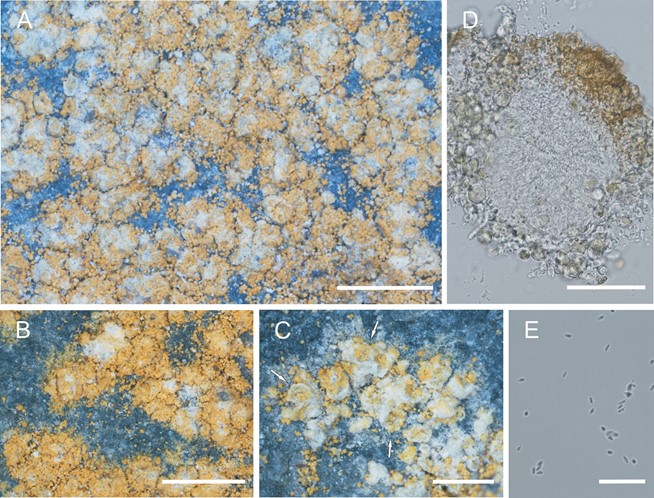Andina citrinoides Wilk & Lücking, sp. nov. FIG. 3
MycoBank number: MB 836179; Index Fungorum number: IF 836179; Facesoffungi number: FoF;
Typification: BOLIVIA. DEPT. LA PAZ: Pelechuco, rocky slope, N exposition, 14°49′21″S, 69°04′06″W, 3720 m, sparse Polylepis racemosa woodlands, 13 Oct 2007, Wilk 7553 (holo- type KRAM-L-71754, isotype LPB).
Diagnosis: Thallus saxicolous, areolate, sorediate, yellow to yellow orange, similar to Flavoplaca citrina (Hoffm.) Arup et al. but differs in smaller soredia, 20‒50 µm in diam, and initially circular soralia. Apothecia not observed.
Etymology: The epithet is named after similarities to the species Flavoplaca citrina.
Thallus ca. 100 µm thick, areolate, irregular in outline, dark yellow to yellow orange, K+ purple, areoles scattered to continuous, 0.2‒0.6 mm wide, irregular, flat to convex, margin entire or crenate, areoles’ surface slightly white pruinose, smooth, more or less dissolved into soredia; vegetative propagules abundant, soredia 20‒50 µm in diam, concolorous with thallus, K+ purple, spread in irregular patterns, but initially soralia laminal and erumpent, more or less round, 0.15‒0.2 mm in diam; prothallus somewhere present, inconspicuous, concolorous with thallus; cortex inconspicuous, 5‒17 µm thick, paraplectenchymatous, necral layer absent, anthraquinone pigments present; algal layer continuous; photobiont trebouxioid, cell globose, 5‒15 µm diam. Apothecia not observed. Pycnidia few, ostiole orange, ±immersed, indistinct, conidia ovoid, 2‒4 × 1‒1.5 µm.
Habitat and distribution: Andina citrinoides grows on rocky slopes with sparse Polylepis forest, on siliceous rocks, in humid places, at an altitude of ca. 3700 m. Known from the Andes in Bolivia.
Remarks: Andina citrinoides resembles members of Flavoplaca. It produces yellow to yellow orange, areolate, sterile thalli, much dissolving into concolorous soredia. Apart from belonging to another subfamily (Flavoplaca being part of Xanthorioideae), A. citrinoides also shows a different distribution, being restricted to South America, whereas most Flavoplaca spp. occur in the Northern Hemisphere, mainly in Europe (Arup et al. 2013a). European species with a morphology corresponding to Flavoplaca citrina were studied in detailed by Arup (2006a) and Vondrák et al. (2009). The latter revealed several cryptic species within the group. Notably, one of them, F. austrocitrina (Vondrák et al.) Arup et al., was recently reported from Argentina based on molecular data (Rosato and Arup 2010), raising the possibility of confusing Andina citrinoides with South American representatives of Flavoplaca.
Within subfamily Teloschistoideae, other taxa with a similar morphology include Haloplaca sorediella (Arup) Arup et al. and H. britannica (R. Sant.) Arup et al. (Laundon 1992; Arup 2006b). These species are within the same Group III as Andina but still phylogenetically, as well as geographically (Haloplaca spp. occur in Europe, mainly the United Kingdom), separate.

Figure 3. Andina citrinoides (Wilk 7553, holotype). A. Habit of thallus. B. A close-up of the yellowish prothallus. C. Circular soralia indicated by the white arrows. D. Cross-section of pycnidium. E. Pycnospores. Bars: A, B = 1 mm; C = 0.5 mm; D = 50 µm; E = 20 µm.
